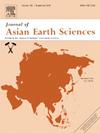Crustal anisotropy and deformation in the South China Block
IF 2.7
3区 地球科学
Q2 GEOSCIENCES, MULTIDISCIPLINARY
引用次数: 0
Abstract
The South China Block has experienced complex tectonic evolution. To better understand the pattern and causes of its crustal deformation, we investigate crustal anisotropy using Pms receiver functions derived from teleseismic waveforms recorded at 64 permanent stations of the China Earthquake Networks Center. We obtain anisotropic results at 55 stations in the region. Our results show that the fast wave direction (FWD) is NE-SW in the Jiangnan Orogenic Belt and NNE-SSW in the northern Cathaysia Block, which align with the local tectonic belts, likely reflecting lithospheric extension related to subduction of the Paleo-Pacific Plate. South of ∼28°N in the Cathaysia Block, the FWD is nearly E-W, possibly controlled by the regional stress regime. In the Yangtze River Delta, the FWDs are more variable and predominantly NE-SW and NW-SE, which likely reflect crosscutting fault systems formed during the Paleo-Pacific subduction since the late Permian and mid-to-late Cenozoic tectonic movements. As a whole, the major cause of the crustal deformation in the eastern South China Block is extension associated with the subduction and rollback of the Paleo-Pacific Plate, with additional contributions from the northeastward compression of the Indochina Block, the collision between the South China and North China blocks, as well as the subduction of the Pacific and Philippine Sea plates.

华南地块地壳各向异性与变形
华南地块经历了复杂的构造演化过程。为了更好地了解其地壳变形的模式和原因,我们利用中国地震台网中心64个常设台站记录的远震波形的Pms接收函数研究了地壳各向异性。我们在该地区的55个站点获得了各向异性结果。结果表明,江南造山带的快波方向为NE-SW,华夏地块北部的快波方向为NNE-SSW,与局部构造带一致,可能反映了古太平洋板块俯冲引起的岩石圈伸展。华夏地块在~ 28°N以南,近东西向,可能受区域应力控制。在长三角地区,演化方向变化较大,以NE-SW和NW-SE为主,可能反映了晚二叠世以来古太平洋俯冲和中晚新生代构造运动期间形成的横切断裂系统。整体而言,华南地块东部地壳变形的主要原因是古太平洋板块的俯冲和回滚引起的伸展,印度支那地块的东北挤压、华南和华北地块的碰撞以及太平洋和菲律宾海板块的俯冲也有影响。
本文章由计算机程序翻译,如有差异,请以英文原文为准。
求助全文
约1分钟内获得全文
求助全文
来源期刊

Journal of Asian Earth Sciences
地学-地球科学综合
CiteScore
5.90
自引率
10.00%
发文量
324
审稿时长
71 days
期刊介绍:
Journal of Asian Earth Sciences has an open access mirror journal Journal of Asian Earth Sciences: X, sharing the same aims and scope, editorial team, submission system and rigorous peer review.
The Journal of Asian Earth Sciences is an international interdisciplinary journal devoted to all aspects of research related to the solid Earth Sciences of Asia. The Journal publishes high quality, peer-reviewed scientific papers on the regional geology, tectonics, geochemistry and geophysics of Asia. It will be devoted primarily to research papers but short communications relating to new developments of broad interest, reviews and book reviews will also be included. Papers must have international appeal and should present work of more than local significance.
The scope includes deep processes of the Asian continent and its adjacent oceans; seismology and earthquakes; orogeny, magmatism, metamorphism and volcanism; growth, deformation and destruction of the Asian crust; crust-mantle interaction; evolution of life (early life, biostratigraphy, biogeography and mass-extinction); fluids, fluxes and reservoirs of mineral and energy resources; surface processes (weathering, erosion, transport and deposition of sediments) and resulting geomorphology; and the response of the Earth to global climate change as viewed within the Asian continent and surrounding oceans.
 求助内容:
求助内容: 应助结果提醒方式:
应助结果提醒方式:


